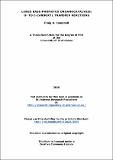Files in this item
Lewis base-promoted organocatalysis : O- to C-carboxyl transfer reactions
Item metadata
| dc.contributor.advisor | Smith, Andrew David | |
| dc.contributor.author | Campbell, Craig D. | |
| dc.coverage.spatial | 238 | en_US |
| dc.date.accessioned | 2012-05-23T09:19:16Z | |
| dc.date.available | 2012-05-23T09:19:16Z | |
| dc.date.issued | 2010-11-30 | |
| dc.identifier | uk.bl.ethos.552704 | |
| dc.identifier.uri | https://hdl.handle.net/10023/2609 | |
| dc.description.abstract | This work describes the application of a variety of Lewis bases, encompassing predominantly N-heterocyclic carbenes (NHCs), but also the use of imidazoles, aminopyridines, amidines and isothioureas, as effective catalysts in the dearomatisation of heterocyclic carbonates, predominantly the rearrangement of oxazolyl carbonates to their C-carboxyazlactone isomers by means of the Steglich rearrangement. This rearrangement reaction has been investigated extensively, with the development of simplified reaction procedures and the invention of domino cascade protocols incorporating this transformation. In an attempt to understand the mechanism of this O- to C-carboxylation process, a number of interesting observations have been made. Firstly, the class of NHC has an important factor in promoting the rearrangement, with triazolinylidenes being the most effective. Secondly, an interesting chemoselectivity has been delineated using triazolium-derived NHCs, prepared using weak bases (typically Et₃N) or strong metallated bases; both alkyl and aryl oxazolyl carbonates undergo smooth rearrangement with triazolinylidenes derived from strong metallated bases such as KHMDS, while only aryl oxazolyl carbonates undergo rearrangement using Et₃N. Extensive effort has focused towards the development of asymmetric variants of these protocols, primarily towards the design, synthesis and evaluation of chiral NHC precatalysts. To this end, a number of chiral azolium salts have been prepared, encompassing a number of different NHC classes, including C₁- and C₂-imidazolinium salts, C₂-imidazolium salts and a range of triazolium salts. Efforts towards the asymmetric catalysis of the Steglich rearrangement of oxazolyl carbonate substrates have given an optimal 66% ee. Similar rearrangements have been demonstrated with the related furanyl heterocyclic substrate class, producing a mixture of α- and γ-carboxybutenolides. In contrast to the analogous oxazolyl carbonates, the regioselectivity of this rearrangement is dependent upon the nature of the Lewis base employed. Amidines and aminopyridines give a mixture of the α- and γ- regioisomers with generally the α-regioisomer being preferred, while a triazolium-derived NHC gives rise to predominantly the thermodynamically more stable γ-carboxybutenolide. Using amidines or aminopyridines, this rearrangement has been shown to proceed via an irreversible C-C bond-forming process, but in contrast, the rearrangement using the NHC proceeds via an equilibrium process with an optimised regioselectivity of >98:2 for the γ-carboxybutenolide regioisomer over the α-regioisomer. Whilst the asymmetric variant using chiral NHCs has proven unfruitful, rearrangements using a chiral isothiourea have given high levels of regioselectivity towards the α- regioisomer and with excellent levels of enantiodiscrimination (77–95% ee). | en_US |
| dc.language.iso | en | en_US |
| dc.publisher | University of St Andrews | |
| dc.rights | Creative Commons Attribution-NonCommercial-ShareAlike 3.0 Unported | |
| dc.rights.uri | http://creativecommons.org/licenses/by-nc-sa/3.0/ | |
| dc.subject | Organocatalysis | en_US |
| dc.subject | Lewis base | en_US |
| dc.subject | N-heterocyclic carbene (NHC) | en_US |
| dc.subject | Steglich rearrangement | en_US |
| dc.subject | Carboxyl transfer | en_US |
| dc.subject | Isothiourea | en_US |
| dc.subject | Quarternary amino acid | en_US |
| dc.subject | Butenolide | en_US |
| dc.subject.lcc | QD262.C26 | |
| dc.subject.lcsh | Catalysis | en_US |
| dc.subject.lcsh | Organic compounds--Synthesis | en_US |
| dc.subject.lcsh | Carbenes (Methylene compounds) | en_US |
| dc.subject.lcsh | Heterocyclic compounds | en_US |
| dc.subject.lcsh | Aromatic compounds | en_US |
| dc.subject.lcsh | Bases (Chemistry) | en_US |
| dc.subject.lcsh | Rearrangements (Chemistry) | en_US |
| dc.title | Lewis base-promoted organocatalysis : O- to C-carboxyl transfer reactions | en_US |
| dc.type | Thesis | en_US |
| dc.contributor.sponsor | Carnegie Trust for the Universities of Scotland | en_US |
| dc.type.qualificationlevel | Doctoral | en_US |
| dc.type.qualificationname | PhD Doctor of Philosophy | en_US |
| dc.publisher.institution | The University of St Andrews | en_US |
This item appears in the following Collection(s)
Except where otherwise noted within the work, this item's licence for re-use is described as Creative Commons Attribution-NonCommercial-ShareAlike 3.0 Unported
Items in the St Andrews Research Repository are protected by copyright, with all rights reserved, unless otherwise indicated.


